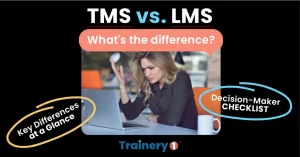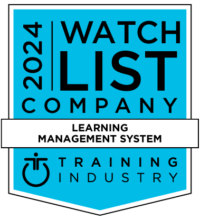Creating a culture of continuous learning has become a top priority for most organizations. But despite $92 billion being spent on workforce training, it seems many programs are still falling short. Only 1 in 5 employees say they would recommend their company’s learning opportunities, while over 40% are dissatisfied with or indifferent about the programs their company offers.
Too often the problem stems from failure to consider training from the learner’s perspective. Managers mandate training that meets requirements for upskilling and compliance purposes, but do not account for employees’ circumstances, perceptions, or how training fits into their overall workload. They often lob training over the fence with too little consideration for how it lands.
Training does not happen in a vacuum, especially in mobile and remote work environments. With companies increasingly reliant on eLearning, it is imperative that managers set realistic expectations for what their employees can achieve within the designated time period. In an era where 55% of the workforce is already looking for a new job, companies can’t afford to ignore employees’ perspectives.
Here are 5 things your employees wish you knew about their online learning experience.
- Distracted learning is a lot like distracted driving.
Now more than ever, employees are being forced to do more with less. Not only are they taking on more work due to workforce reductions, but also work-from-home distractions are all around, including the demands of serving as full-time caregivers and part-time teachers for their children. This pressure to accomplish more, faster often leads to errors in judgment and overlooking essentials—just like it does on the road.
Employers can help overstretched employees focus on learning by offsetting some of their workload and building learning objectives into their performance goals. Some of the burden can be alleviated by providing paid on-the-clock training, so employees do not have to sacrifice their personal time.
- Insufficient communication about opportunities instills mistrust.
Good communication has a positive impact on an employee’s experience, engagement, and performance. However, only 30% of employees say their company’s communication is highly effective, and 1 in 5 say it’s low or not at all effective. When it comes to training, insufficient communication comes across as an insincere commitment to employees—managers say continuous learning is a priority, but do not prioritize adequate information.
Managers can overcome this by communicating early and often about learning and development opportunities to build a culture of engagement and commitment to helping individuals succeed. Brenda Thompson, Director of Operations at JER HR Group suggests “this can be done through career pathing, mapping skills development to goals, and including training goals as part of performance management.”
- Lack of notice about training deadlines is irritating.
COVID stress has stretched employees to their limit. Already 2 out of 5 employees say they don’t have time to learn, and failure to provide sufficient notice about training deadlines is just piling on more stress. Only one-third of employees say their managers do a good job of keeping them informed about important matters, which means there’s clearly room for improvement.
Using a Learning Management System can help by alerting employees and their managers when required training is due, especially on safety and compliance topics. This helps avoid the last-minute scramble. With automatic notices delivered well in advance, employees can plan for training without having to squeeze it in and rush through it.
- Training without diversity representation speaks poorly of your DEI strategies.
When companies pay lip service to important issues, employees can see through it quickly, and right now, DEI is an important issue. But only half of employees believe their employer is meeting its DEI goals. The pandemic has exacerbated exclusion of under-represented groups, and if training programs aren’t relatable and inclusive to all employees, you’ll lose their interest, attention and trust.
For training to be effective, employees must be able to see themselves represented in training materials. That means using diverse, multicultural individuals, inclusive language, materials that are free of unconscious biases and delivery methods that accommodate different learning styles and those with disabilities.
- Outdated content or boring presentations make training irrelevant and forgettable.
Stale training content and boring delivery will sap the life out of any learning material, regardless of how important it is. Research shows that people forget 90% of what they learned within a week, and 14% of employees say the learning materials their company provides are not relevant and 1 in 5 say they’re not engaging.
Instead, managers must ensure that online learning materials feature an integrated learning approach with dynamic, up-to-date, and relatable content. This not only encourages employee participation and increases knowledge adoption and retention; it also builds a more positive workplace culture in general.
Delivering effective, engaging, relevant learning opportunities is essential for employee retention, but managers cannot simply dispatch training and sit back. Managers and instructors must be dialed in closely to the feedback loop on the programs they offer and be considerate of employees’ expectations and circumstances.







